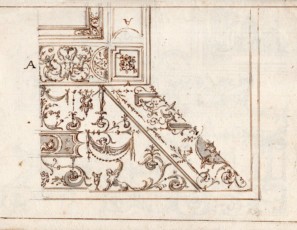Art of Transformation
From grotesque to Carnival
A tour by the fascinating world of the grotesque. The art that the French historian André Chastel called “the ornament without name” and consists of vast fantastic ornamental repertoire that has as its object the fusion of elements and the mixture of natural forms, vegetables and figures human beings. The origin of this art is in the decorative paintings discovered in the ancient Domus Aurea of Nero in Rome. The surprise of this discovery in the Renaissance encouraged artists and creators to make copies and versions on these subjects (influencing the world of goldsmithing, architecture, sculpture and object arts).
This exhibition shows more than a hundred engravings and drawings from 16th to 19th centuries by Flemish, French, Italian, and Spanish artists and illustrate the success of this formula during the Renaissance, the Baroque and other later trends, such as rococo chineries and even the ornamental repertoire of the “Indianas”, etc. In addition, the exhibition shows series of engravings on the Metamorphoses of Ovid and gathers prints about the carnival, where transformation also takes place.
Related pieces
-

Withouth title (Grotesque)
-

Ornaments and grotesque
-

Vases and candeleri
-

Carnaval
-

Vass
-

Vases and jars
-

Disparate de carnaval
-

Grotesque
-

Grotesque motifs
-

Atlants and cariatids
-

Grotesque
-

Grotesque motifs
-

Sicut Foenum Dies Elus Sicut Flos Agri Sic Efflorebit
-

Grotteschi. Pair of prints
-

Five prints. “Chinoiseries”
-

Grotesque
-

Grotesque
-

Architecture grotesque
-

Grotesque ornamentation
-

Nil florere vetat
-

Pair of prints with parable of ungrateful servant
-

Pair of prints with grotesque motifs
-

Pair of prints with grotesque motifs
-

Cariatide
-

Pair of grotesque prints
-

Pair of prints with grotesque motifs
-

Pair of grotesque faces
-

Chinoiserie
-

Pair of grotesque motifs
-

Floral motifs with human shapes
-

Lot of 6 prints with grotesque motifs
-

Disparate matrimonial
-

De los deleytes se sigue el dolor, y la miseria
-

Masks abroad
-

Prints from “The Metamorphosis” from Ovid
-

Prints from “The Metamorphosis” from Ovid
-

Grotesque heads
-

Grotesque
-

Grotesque
-

Grotesque with sfinxes, eagles and floral motifs
-

Grotesque with musical motifs
-

Grotesque with figures and a tree
-

Grotesque with decorative motifs
-

Grotesque
-

Ornamental motif with grotesque
-

Decorative motifs and other motifs
-

Ornamental motif with grapes
-

Floral candle
-

Ornamental motifs with sphinxes
-

Ornamental and zoomorfic motifs
-

Acanthus leaves
-

Ceiling decoration with Barcelona’s shield
-

Four drawings used for a motion film
-

Drawing for an “indiana”
-

Pair of drawings for “indianas”
-

Drawing for “indiana”
-

Drawing for “indiana”
-

Drawing for “indiana”
-

Drawing for “indiana”
-

Drawing for “indiana”
-

Drawing for “indiana”
-

Drawing for “indiana”
-

Drawing for “indiana”
-

Drawing for “indiana”
-

Drawing for “indiana”
-

Apollo and Dafne
-

Couple costumed
-

Grotesque face size

